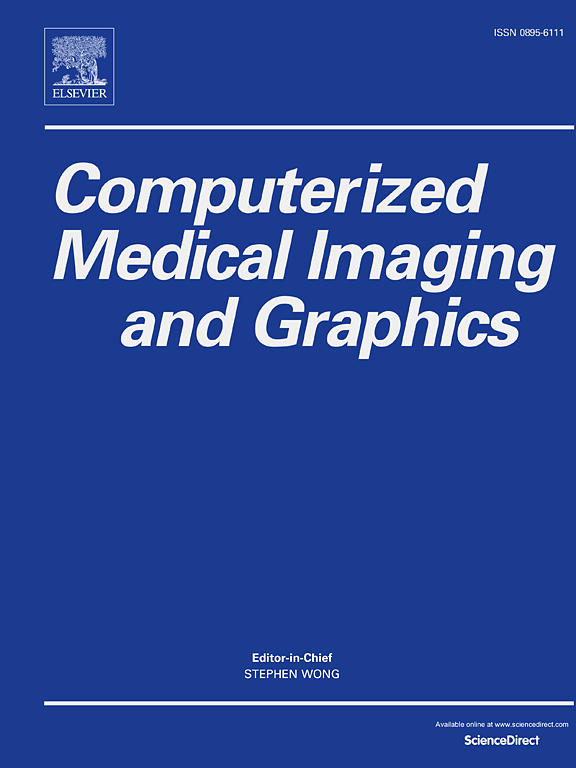A novel generative model for brain tumor detection using magnetic resonance imaging
IF 4.9
2区 医学
Q1 ENGINEERING, BIOMEDICAL
Computerized Medical Imaging and Graphics
Pub Date : 2025-02-19
DOI:10.1016/j.compmedimag.2025.102498
引用次数: 0
Abstract
Brain tumors are a disease that kills thousands of people worldwide each year. Early identification through diagnosis is essential for monitoring and treating patients. The proposed study brings a new method through intelligent computational cells that are capable of segmenting the tumor region with high precision. The method uses deep learning to detect brain tumors with the “You only look once” (Yolov8) framework, and a fine-tuning process at the end of the network layer using intelligent computational cells capable of traversing the detected region, segmenting the edges of the brain tumor. In addition, the method uses a classification pipeline that combines a set of classifiers and extractors combined with grid search, to find the best combination and the best parameters for the dataset. The method obtained satisfactory results above 98% accuracy for region detection, and above 99% for brain tumor segmentation and accuracies above 98% for binary classification of brain tumor, and segmentation time obtaining less than 1 s, surpassing the state of the art compared to the same database, demonstrating the effectiveness of the proposed method. The new approach proposes the classification of different databases through data fusion to classify the presence of tumor in MRI images, as well as the patient’s life span. The segmentation and classification steps are validated by comparing them with the literature, with comparisons between works that used the same dataset. The method addresses a new generative AI for brain tumor capable of generating a pre-diagnosis through input data through Large Language Model (LLM), and can be used in systems to aid medical imaging diagnosis. As a contribution, this study employs new detection models combined with innovative methods based on digital image processing to improve segmentation metrics, as well as the use of Data Fusion, combining two tumor datasets to enhance classification performance. The study also utilizes LLM models to refine the pre-diagnosis obtained post-classification. Thus, this study proposes a Computer-Aided Diagnosis (CAD) method through AI with PDI, CNN, and LLM.

一种新的磁共振成像脑肿瘤检测生成模型
脑肿瘤是一种每年夺去全世界数千人生命的疾病。通过诊断进行早期识别对于监测和治疗患者至关重要。本研究提出了一种通过智能计算细胞对肿瘤区域进行高精度分割的新方法。该方法使用深度学习,通过“你只看一次”(Yolov8)框架检测脑肿瘤,并在网络层的末端使用能够遍历检测区域的智能计算细胞进行微调过程,分割脑肿瘤的边缘。此外,该方法使用分类管道,将一组分类器和提取器结合网格搜索,寻找数据集的最佳组合和最佳参数。该方法的区域检测准确率在98%以上,脑肿瘤分割准确率在99%以上,脑肿瘤二值分类准确率在98%以上,分割时间小于1 s,优于同类数据库,证明了该方法的有效性。该方法提出通过数据融合对不同数据库进行分类,从而对MRI图像中肿瘤的存在以及患者的寿命进行分类。通过将分割和分类步骤与文献进行比较,以及使用相同数据集的作品之间的比较,验证了分割和分类步骤。该方法解决了一种新的脑肿瘤生成人工智能,能够通过大语言模型(LLM)的输入数据生成预诊断,并可用于辅助医学成像诊断的系统。作为贡献,本研究采用新的检测模型结合基于数字图像处理的创新方法来改进分割指标,以及使用数据融合,结合两个肿瘤数据集来提高分类性能。本研究还利用LLM模型对分类后得到的预诊断进行细化。因此,本研究提出了一种结合PDI、CNN和LLM的人工智能计算机辅助诊断(CAD)方法。
本文章由计算机程序翻译,如有差异,请以英文原文为准。
求助全文
约1分钟内获得全文
求助全文
来源期刊
CiteScore
10.70
自引率
3.50%
发文量
71
审稿时长
26 days
期刊介绍:
The purpose of the journal Computerized Medical Imaging and Graphics is to act as a source for the exchange of research results concerning algorithmic advances, development, and application of digital imaging in disease detection, diagnosis, intervention, prevention, precision medicine, and population health. Included in the journal will be articles on novel computerized imaging or visualization techniques, including artificial intelligence and machine learning, augmented reality for surgical planning and guidance, big biomedical data visualization, computer-aided diagnosis, computerized-robotic surgery, image-guided therapy, imaging scanning and reconstruction, mobile and tele-imaging, radiomics, and imaging integration and modeling with other information relevant to digital health. The types of biomedical imaging include: magnetic resonance, computed tomography, ultrasound, nuclear medicine, X-ray, microwave, optical and multi-photon microscopy, video and sensory imaging, and the convergence of biomedical images with other non-imaging datasets.

 求助内容:
求助内容: 应助结果提醒方式:
应助结果提醒方式:


